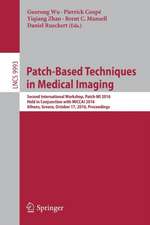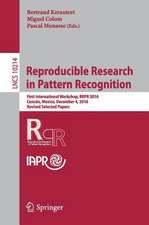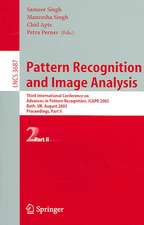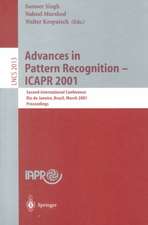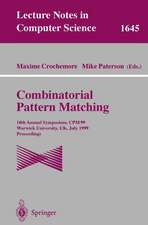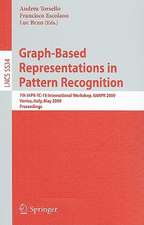Advanced Algorithmic Approaches to Medical Image Segmentation: State-of-the-Art Applications in Cardiology, Neurology, Mammography and Pathology: Advances in Computer Vision and Pattern Recognition
Editat de S. Kamaledin Setarehdan, Sameer Singhen Limba Engleză Hardback – 11 dec 2001
This book focuses primarily on state-of-the-art model-based segmentation techniques which are applied to cardiac, brain, breast and microscopic cancer cell imaging. It includes contributions from authors based in both industry and academia and presents a host of new material including algorithms for:
- brain segmentation applied to MR;
- neuro-application using MR;
- parametric and geometric deformable models for brain segmentation;
- left ventricle segmentation and analysis using least squares and constrained least squares models for cardiac X-rays;
- left ventricle analysis in echocardioangiograms;
- breast lesion detection in digital mammograms;
detection of cells in cell images.
As an overview of the latest techniques, this book will be of particular interest to students and researchers in medical engineering, image processing, computer graphics, mathematical modelling and data analysis. It will also be of interest to researchers in the fields of mammography, cardiology, pathology and neurology.
| Toate formatele și edițiile | Preț | Express |
|---|---|---|
| Paperback (1) | 1289.93 lei 6-8 săpt. | |
| SPRINGER LONDON – 5 sep 2012 | 1289.93 lei 6-8 săpt. | |
| Hardback (1) | 1649.61 lei 6-8 săpt. | |
| SPRINGER LONDON – 11 dec 2001 | 1649.61 lei 6-8 săpt. |
Din seria Advances in Computer Vision and Pattern Recognition
- 20%
 Preț: 998.36 lei
Preț: 998.36 lei - 20%
 Preț: 409.78 lei
Preț: 409.78 lei - 20%
 Preț: 654.70 lei
Preț: 654.70 lei - 20%
 Preț: 775.30 lei
Preț: 775.30 lei - 20%
 Preț: 867.13 lei
Preț: 867.13 lei - 20%
 Preț: 241.87 lei
Preț: 241.87 lei - 20%
 Preț: 659.83 lei
Preț: 659.83 lei - 20%
 Preț: 1084.17 lei
Preț: 1084.17 lei - 20%
 Preț: 328.60 lei
Preț: 328.60 lei - 20%
 Preț: 650.08 lei
Preț: 650.08 lei - 20%
 Preț: 644.66 lei
Preț: 644.66 lei - 20%
 Preț: 652.54 lei
Preț: 652.54 lei - 20%
 Preț: 646.80 lei
Preț: 646.80 lei - 20%
 Preț: 993.60 lei
Preț: 993.60 lei - 20%
 Preț: 1174.92 lei
Preț: 1174.92 lei - 20%
 Preț: 646.80 lei
Preț: 646.80 lei - 20%
 Preț: 672.36 lei
Preț: 672.36 lei - 20%
 Preț: 1166.52 lei
Preț: 1166.52 lei - 20%
 Preț: 920.33 lei
Preț: 920.33 lei - 20%
 Preț: 825.78 lei
Preț: 825.78 lei - 20%
 Preț: 666.58 lei
Preț: 666.58 lei - 18%
 Preț: 953.65 lei
Preț: 953.65 lei - 20%
 Preț: 999.35 lei
Preț: 999.35 lei - 20%
 Preț: 655.02 lei
Preț: 655.02 lei - 20%
 Preț: 595.16 lei
Preț: 595.16 lei - 20%
 Preț: 647.61 lei
Preț: 647.61 lei - 20%
 Preț: 658.33 lei
Preț: 658.33 lei - 20%
 Preț: 991.46 lei
Preț: 991.46 lei - 20%
 Preț: 994.08 lei
Preț: 994.08 lei - 20%
 Preț: 1062.57 lei
Preț: 1062.57 lei - 20%
 Preț: 985.16 lei
Preț: 985.16 lei - 20%
 Preț: 640.35 lei
Preț: 640.35 lei - 20%
 Preț: 656.03 lei
Preț: 656.03 lei - 18%
 Preț: 950.52 lei
Preț: 950.52 lei - 20%
 Preț: 652.41 lei
Preț: 652.41 lei - 20%
 Preț: 644.81 lei
Preț: 644.81 lei - 20%
 Preț: 996.40 lei
Preț: 996.40 lei
Preț: 1649.61 lei
Preț vechi: 2062.02 lei
-20% Nou
Puncte Express: 2474
Preț estimativ în valută:
315.64€ • 329.56$ • 261.24£
315.64€ • 329.56$ • 261.24£
Carte tipărită la comandă
Livrare economică 04-18 aprilie
Preluare comenzi: 021 569.72.76
Specificații
ISBN-13: 9781852333898
ISBN-10: 1852333898
Pagini: 668
Ilustrații: XXVII, 636 p.
Dimensiuni: 155 x 235 x 46 mm
Greutate: 1.42 kg
Ediția:2002
Editura: SPRINGER LONDON
Colecția Springer
Seria Advances in Computer Vision and Pattern Recognition
Locul publicării:London, United Kingdom
ISBN-10: 1852333898
Pagini: 668
Ilustrații: XXVII, 636 p.
Dimensiuni: 155 x 235 x 46 mm
Greutate: 1.42 kg
Ediția:2002
Editura: SPRINGER LONDON
Colecția Springer
Seria Advances in Computer Vision and Pattern Recognition
Locul publicării:London, United Kingdom
Public țintă
ResearchCuprins
1. Principles of Image Generation.- 1.1 Introduction.- 1.2 Ultrasound Image Generation.- 1.3 X-Ray Cardiac Image Generation.- 1.4 Magnetic Resonance Image Generation.- 1.5 Computer Tomography Image Generation.- 1.6 Positron-Emission Tomography Image Generation.- 1.7 Comparison of Imaging Modalities: A Summary.- 2. Segmentation in Echocardiographic Images.- 2.1 Introduction.- 2.2 Heart Physiology and Anatomy.- 2.3 Review of LV Boundary Extraction Techniques Applied to Echocardiographic Data.- 2.4Automatic Fuzzy Reasoning-Based Left Ventricular Center Point Extraction.- 2.5 A New Edge Detection in the Wavelet Transform Domain.- 2.6 LV Segmentation System.- 2.7 Conclusions.- 2.8 Acknowledgments.- 3. Cardiac Boundary Segmentation.- 3.1 Introduction.- 3.2 Cardiac Anatomy and Data Acquisitions for MR, CT, Ul-trasound and X-Rays.- 3.4 Model-Based Pattern Recognition Methods for LV Modeling.- 3.5 Left Ventricle Apex Modeling: A Model-Based Approach.- 3.6 Integration of Low-Level Features in LV Model-Based Cardiac Imaging: Fusion of Two Computer Vision Systems.- 3.7 General Purpose LV Validation Technique.- 3.8 LV Convex Hulling: Quadratic Training-Based Point Modeling.- 3.9 LV Eigen Shape Modeling.- 3.10 LV Neural Network Models.- 3.11 Comparative Study and Summary of the Characteristics of Model-Based Techniques.- 3.12 LV Quantification: Wall Motion and Tracking.- 3.13 Conclusions.- 4. Brain Segmentation Techniques.- 4.1 Introduction.- 4.2 Brain Scanning and its Clinical Significance.- 4.3 Region-Based 2-D and 3-D Cortical Segmentation Techniques.- 4.4 Boundary/Surface-Based 2-D and 3-D Cortical Segmentation Techniques: Edge, Reconstruction, Parametric and Geometric Snakes/Surfaces.- 4.5 Fusion of Boundary/Surface with Region-Based 2-D and 3-D Cortical Segmentation Techniques.- 4.6 3-D Visualization Using Volume Rendering and Texture Mapping.- 4.7 A Note on fMRI: Algorithmic Approach for Establishing the Relationship Between Cognitive Functions and Brain Cortical Anatomy.- 4.8 Discussions: Advantages, Validation and New Challenges i 2-D.- 4.9 Conclusions and the Future.- 5. Segmentation for Multiple Sclerosis Lesion.- 5.1 Introduction.- 5.2 Segmentation Techniques.- 5.3 AFFIRMATIVE Images.- 5.4 Image Pre-Processing.- 5.5 Quantification of Enhancing Multiple Sclerosis Lesions.- 5.6 Quadruple Contrast Imaging.- 5.7 Discussion.- 6. Finite Mixture Models.- 6.1 Introduction.- 6.2 Pixel Labeling Using the Classical Mixture Model.- 6.3 Pixel Labeling Using the Spatially Variant Mixture Model.- 6.4 Comparison of CMM and SVMM for Pixel Labeling.- 6.5 Bayesian Pixel Labeling Using the SVMM.- 6.6 Segmentation Results.- 6.7 Practical Aspects.- 6.8 Summary.- 6.9 Acknowledgements.- 7. MR Spectroscopy.- 7.1 Introduction.- 7.2 A Short History of Neurospectroscopic Imaging and Segmentation in Alzheimer’s Disease and Multiple Sclerosis.- 7.3 Data Acquisition and Image Segmentation.- 7.4 Proton Magnetic Resonance Spectroscopic Imaging and Segmentation in Multiple Sclerosis.- 7.5 Proton Magnetic Resonance Spectroscopic Imaging and Segmentation of Alzheimer’s Disease.- 7.6 Applications of Magnetic Resonance Spectroscopic Imaging and Segmentation.- 7.7 Discussion.- 7.8 Conclusion.- 8. Fast WM/GM Boundary Estimation.- 8.1 Introduction.- 8.2 Derivation of the Regional Geometric Active Contour Model from the Classical Parametric Deformable Model.- 8.3 Numerical Implementation of the Three Speed Functions in the Level Set Framework for Geometric Snake Propagation.- 8.4 Fast Brain Segmentation System Based on Regional Level Sets.- 8.5 MR Segmentation Results onSynthetic and Real Data.- 8.6 Advantages of the Regional Level Set Technique.- 8.7 Discussions: Comparison with Previous Techniques.- 8.8 Conclusions and Further Directions.- 9. Digital Mammography Segmentation.- 9.1 Introduction.- 9.2 Image Segmentation in Mammography.- 9.3 Anatomy of the Breast.- 9.4 Image Acquisition and Formats.- 9.5 Mammogram Enhancement Methods.- 9.6 Quantifying Mammogram Enhancement.- 9.7 Segmentation of Breast Profile.- 9.8 Segmentation of Microcalcifications.- 9.9 Segmentation of Masses.- 9.10 Measures of Segmentation and Abnormality Detection.- 9.11 Feature Extraction From Segmented Regions.- 9.12 Public Domain Databases in Mammography.- 9.13 Classification and Measures of Performance.- 9.14 Conclusions.- 9.15 Acknowledgements.- 10. Cell Image Segmentation for Diagnostic Pathology.- 10.1 Introduction.- 10.2 Segmentation.- 10.3 Decision Support System for Pathology.- 10.4 Conclusion.- 11. The Future in Segmentation.- 11.1 Future Research in Medical Image Segmentation.
Caracteristici
No other book deals exclusively with the subject of medical image segmentation It discusses state-of-the-art techniques, comprising contributions from authors from both industry and academia











